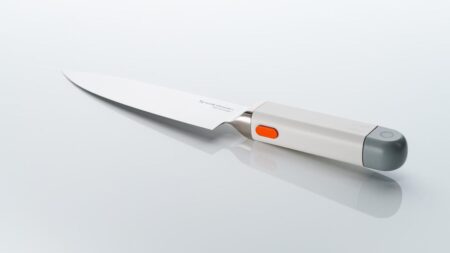No kitchen tool requires more careful storage than knives — for your safety and the safety if the blades — and no storage option is cooler than fixing them to the wall for all to see. While canvas wraps, wooden blocks and drawer organizers all serve this purpose, the mighty magnetic knife strip is my clear pick. Knife strips save space, they won’t dull those precious edges (when used properly), and they give your kitchen an industrial, professional look.┬Ā
A magnetic knife strip is invariably the first kitchen purchase I make in a new home. I’m a culinary-school-trained nonchef, but even chef chefs recommend this storage tool: “I first tried a magnetic strip in my home kitchen a few years ago, and I’m hooked,” says Melissa Araujo, chef-owner of┬ĀAlma Caf├®┬Āin New Orleans. ┬Ā
A magnetic strip has distinct advantages over any other type of knife storage.
If you wonder what’s so great about knife strips compared to other forms of kitchen blade storage, here are three reasons, personal and chef-approved, to add an affordable magnetic knife strip to your home.
The best part? A quality magnetic strip for your finest blades typically runs under $30.
1. Magnetic knife strips save space
There are so many great reasons to own a magnetic knife strip, so it’s hard to know where to start. However, as someone who has usually been at a loss for meaningful counter space in urban apartments, I’m going to go with this one. Freeing up space that would otherwise be occupied by a knife block or in a silverware drawer is perhaps the number one reason for home cooks to consider a magnetic knife strip.
Read more:┬ĀThese Kitchen Organizers Will Give You Miles of Extra Counter Space
Space-saving is also a motivating factor in professional kitchens. “I even started using them in my restaurants,” says Araujo. “Plus, they look cool, and you can see all your knives at the same time, so it’s easy to know which one to pull,” she says.
2. They keep knives sharper for longer
A knife strip won’t dull your blades the way some storage types do.
Whether you have new or freshly sharpened knives, storing them on a magnetic knife strip has myriad benefits in staying sharp. (If your knives behave more like bludgeons than blades, first things first, get them sharpened.)
First, the knife strip prevents your knives from knocking around in a utensil drawer, which can lead to dulling over time. Wooden knife blocks are OK for this purpose, but they still create a little more wear and tear than simply mounting them al fresco does. And, as Araujo’s point above, you’re not constantly pulling them in and out of the block in a guessing game of which-knife-went-where several times a day.
Read more:┬ĀWant to Completely Ruin Your Kitchen Knives? Here’s How
For me, the knife strip also enables another element to keep knives sharp. The honing steel isn’t a sharpener, per se, but its function is to help preserve the sharpness. Even as someone who was trained to use it, I have a very out-of-sight, out-of-mind relationship with this tool, but with the magnetic strip, the honing steel is very much in sight all of the time, which means I’m more likely to employ it.
3. A strip is more sanitary than a knife block
Knife blocks can grow mold in the slots and are difficult to clean, making magnetic knife strips a more sanitary storage option.
Are you concerned about places in your kitchen where bacteria may be hiding? Your magnetic strip is not one. But your knife blockŌĆ”?
“Knife blocks trap moisture in the slots,” says Araujo, which can cause microorganisms like mold spores and bacteria to thrive. (She would know, in a humid place like New Orleans. What’s the dew point in your neighborhood right now?) Even if you put your knives away without thoroughly drying them first — don’t do this, but if you do — at least the magnetic strip gives them some air circulation. This helps not only with keeping things sanitary, but also with keeping things sharp.
Best practices for using a magnetic knife strip
Always put the knives spine-down on your strip so you don’t chip the edges.
If you’re now convinced of the superiority of the magnetic knife strip, there are a few things to consider.
Get a good one: “Spend the money,” advises Araujo. Cheap ones aren’t strong, especially if you have solid, high-quality, heavy-duty knives.” Fortunately, the price can only go so high, and if you’ve dropped some real coin for your professional-grade knives, the magnetic strip will be a minimal investment toward keeping them in good condition.┬Ā
Some magnetic knife strips we like:
The most straightforward magnetic strip look: I’ve owned this $20 metal holder several times over. It has tens of thousands of positive Amazon ratings, comes in six different sizes, and maxes out around $35 for a 24-inch strip.
I swear by this $20 knife strip from Amazon.
Another good option is this $20 model with a dual-strip look┬Āfor a comprehensive storage solution.
There are magnetic strips that hold more than just knives.
An Amazon best seller, this $21 magnetic strip has a wood finish to suit a particular aesthetic, if that’s why you’re hesitant to give up a wooden knife block.┬Ā
Wooden strips are also less likely to ding your cutlery if you accidentally set a knife on its blade first. CNET’s Home and Kitchen Editor David Watsky uses this one.
This simple wooden knife strip is suitable for three to four blades.┬Ā
Mount it correctly: If your knife collection is small, you may be able to get away with the double-stick tape mounting that is included with some magnetic strips, but the much safer bet is to go the hardware route to make sure it is flush against the wall. I had a pro drill into the tile backsplash in my kitchen to accommodate the knife strip. It looks sharp and is highly secure. (Having your knives clatter to the ground because of an inappropriately installed strip isn’t exactly enabling all the benefits of owning one.)
Store your knives appropriately: “ALWAYS put the knives spine-down so you don’t chip the edges,” advises Araujo. When pulling a knife off the strip, it’s also essential to tilt the blade away from the strip, rather than slide it off, to help preserve its sharpness.
Read the full article here














